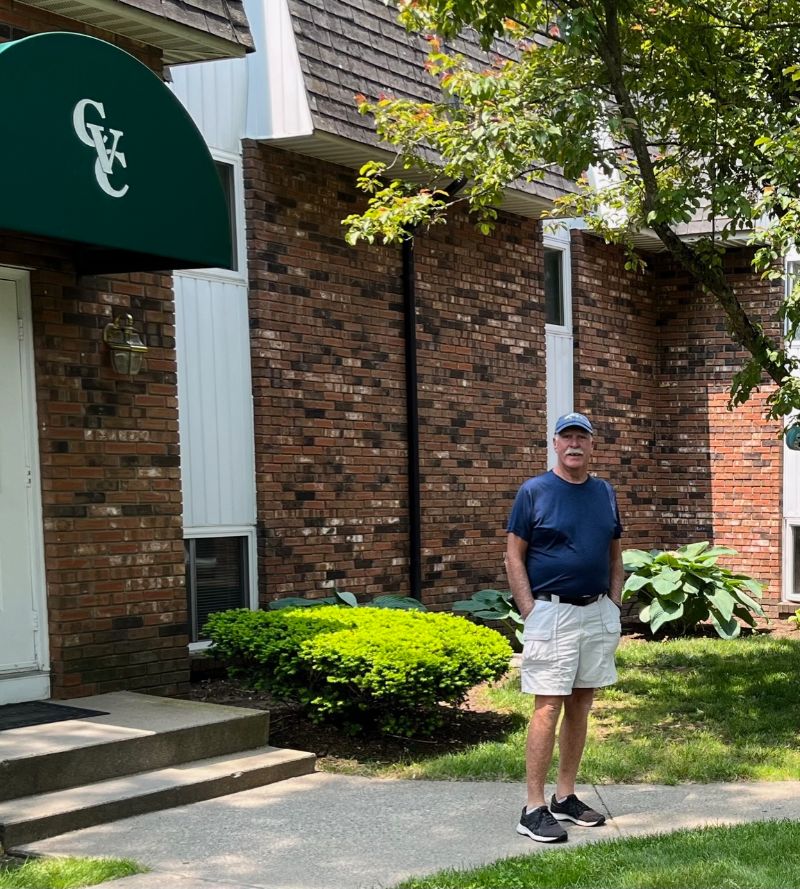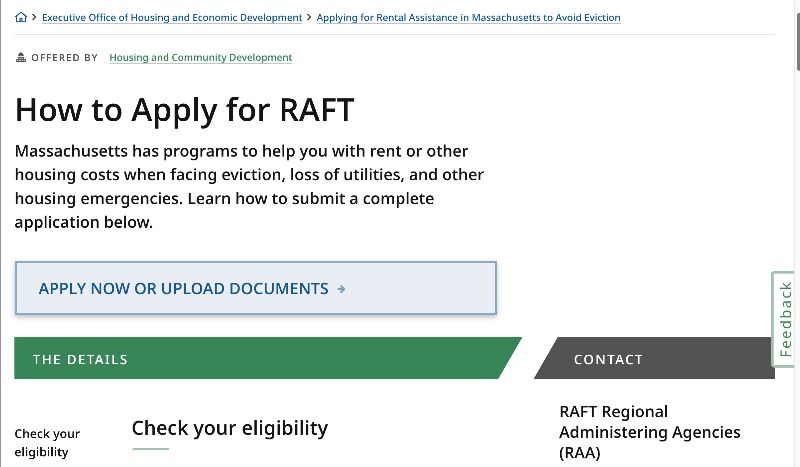Three Years After Covid Shutdowns, Same Problems Still Frustrate the Rental Assistance Application Process
| . Posted in News - 0 Comments
By Eric Weld, MassLandlords, Inc.
Please Note: This article was written in 2023. For the most up-to-date information, visit our RAFT page.
By some accounts, applying for state-funded rental assistance, like RAFT, may have improved since the early days of the pandemic. RAFT (Rental Assistance for Families in Transition) is the state’s main funding program for people whose finances and abilities to pay housing expenses were detrimentally affected by illness and pandemic-related business shutdowns. Though the program is funded and overseen by the Department of Housing and Community Development (DHCD), applications are taken in and administered by several regional agencies across the state.

MassLandlords member Michael Bensche, pictured in front of his rental building in Longmeadow, has had some recent success with RAFT, but also describes some frustrations with the application process. Image: cc by-sa Michael Bensche.
While RAFT may be somewhat better organized now, problems with the application process persist, for sure, as MassLandlords members attest below.
It’s also difficult to determine if issues around language barriers, nonresponse and scores of applications mysteriously “timing out” have been corrected because DHCD doesn’t publicly disclose statistics such as the number of applications it receives, accepts and rejects.
Through 2020 and 2021, tens of thousands of applications were mysteriously “timed out” with no explanation. A MassLandlords lawsuit against DHCD, seeking information that might inform why so many applicants were rejected and timed out, is still active, though snagged in court. DHCD reports the distribution of more than $300 million in assistance to renters on a running dashboard on the mass.gov website. But without disclosure of key statistics, like applications accepted and rejected, we have no way of knowing if thousands continue to be timed out and unfunded.
We will continue pursuing our DHCD lawsuit to discover more information that can shed light on why applications are timed out without explanation, and what exactly happened that resulted in many individuals and families losing their homes because they couldn’t procure rental assistance.

An introductory screen at mass.gov makes applying for rental assistance look easy. MassLandlords members who have recently applied on behalf of tenants know better. Image: cc by-sa mass.gov.
Pandemic Rental Assistance
RAFT is a long-running program, in existence since 2005. RAFT benefits increased during the pandemic from $4,000 annually to up to $10,000. Recipients may use these benefits to pay rent or other housing-related expenses. (The grant amount decreased briefly, to $7,000 per 12-month period, but has since gone back up to $10,000, where it remains.)
Other ad hoc rental assistance programs created during the pandemic and partly funded with federal grants included ERAP (Emergency Rental Assistance Program) and ERMA (Emergency Rental and Mortgage Assistance). The ERAP program provided up to 18 months of rental and housing assistance with no dollar limit, as well as funding to help pay utilities. Both of these temporary programs ended, ERMA in 2021 and ERAP in 2022.
RAFT Application Portal
Some might say that RAFT had nowhere to go but up following a rocky year and a half when Covid-19 pandemic setbacks upended people’s finances and housing, and seemed to overwhelm the funding assistance program.
And, at least in some cases, some old wrinkles in the system may have been smoothed.
DHCD has attempted to streamline its operations by introducing a central portal through which applications are submitted. From there, applications are assigned to Regional Administering Agencies (RAAs) for processing. One big improvement in the application process is the addition of a “save and resume” feature on the application website that allows people to begin an application, save it and return to complete it later, rather than having to start all over again if the process gets interrupted.
Mixed Experiences, Mostly Negative
MassLandlords members who have recently applied for rental assistance on tenants’ behalf report a mixed bag of experiences, though leaning negative. For some, it’s an exercise in patience, frustration and perseverance.
“All in all, the new system is much better than the old,” admits Michael Bensche, a landlord in Longmeadow. Bensche cites similar frustrations with the system as other landlord applicants. “But then, recently, I had one that was only about two weeks from application to bank deposit, showing that the new system has potential.”
“My experience applying for rental assistance with the new system has not been good,” notes Roger Williams of Springfield, who most recently applied for RAFT on March 29, 2023, on behalf of a tenant. “I have applied for rental assistance before, several times with the old system. I applied four times with the new system for the same tenant. The first three times were not successful due to the tenant not doing what they were supposed to do. My latest application is ‘under review’ and has passed the 21-day application period. Hopefully, I will get paid this time.”
Not Working Together
The problem that Williams specifies is a common complaint. Landlords can initiate applications and submit documents from their end, but the entire process relies on cooperation and participation from tenants as well. When tenants fail to submit their information as part of the application process on time, the process snags.
“My biggest criticism is that the landlord is not notified if the tenant does not give requested information,” says Williams. “We don’t find out until it is too late and the application is closed. Then a new application has to be started. If we were notified that the tenant did not give the requested information, we could talk to the tenant about supplying the information.”
Another member with properties in Worcester and Framingham, who asked that his name not be used, notes similar frustrations. “I have some recent experience with RAFT, via RCAP and CMHA in Worcester,” he describes. “It has been pretty negative, some due to my lack of knowledge of these programs, but some due to how poorly designed they are.”
The member cites the lack of information flow and communication among the biggest frustrations. “There is no visibility into the process,” he says, as applicants await responses from RAAs for six to eight weeks from initial submission. “No one who answers the phone or when I visited in person was able to tell me when the application would get processed. When the money arrives, if it arrives, the tenant is likely even more behind and you have to do the whole application dance again.”
Rent Falling Further Behind
That is one of the main problems with the current structure of RAFT, says Jo Landers, who rents properties in Holyoke.
“One big problem is that there’s a complete disincentive for tenants to pay rent while their application is pending,” she says. “And the applications are taking so long that by the time they get back to us, the arrears are building even more.”
And, as the Worcester landlord points out, in cases in which available RAFT funds won’t cover the entire cost of arrears due, RAFT asks tenants to sign an agreement stating that they will be responsible for the leftover money owed to landlords that is not covered by the RAFT grant. But there appears to be no repercussions for tenants who refuse or neglect to sign such agreements. In many cases, landlords have no recourse but to absorb that cost or move toward eviction.
DHCD Correspondence to All Applicants?
Landers has applied for RAFT multiple times in recent years, sometimes several times for the same tenant. She echoes similar problems with the process as other landlords. She has also had applications rejected or timed out because her tenant didn’t submit requested information. Sometimes it’s a technical issue on the tenant’s part, she says. Other times the tenant claims not to have received the request from the RAA.
If DHCD only installed a mechanism in which landlords are copied on correspondence with their tenants, or in which all communications pertaining to one funding application went to all parties on the application, who knows how many thousands more applications might remain viable, she notes.
Bensche agrees. “They give each party a separate application number,” he says. “Why they want to have different app numbers for the tenant and landlords is beyond me. I have been asked to upload documents to case numbers I have never seen.”
Wish List of Remedies
Landers and other members have seen the RAFT application process work on occasion. But it’s the general inefficiency and inconsistencies that they complain about. Too many times they’re asked to submit documents that they’ve already submitted, sometimes for a third time. And when an application times out because a tenant has lapsed in submitting requested information, landlords have to begin the application process all over again, resubmitting the same information, wastefully repeating the process, again two or three times in some cases.
“Deal with whatever is causing these horrendous delays, number one,” says Landers. That likely means more money from the state to shore up extra personnel, she acknowledges. “And do something about this issue of disincentivizing tenants from paying rent or partial rent while applications are pending.”
Further down the wish list, she would request some way to report problems or give feedback to DHCD. (The application website does list phone numbers and chats available with Mass 211, a statewide nonprofit resource that provides information and assistance for a menu of health and human services programs, including housing and rental assistance.)
Some Advice for RAFT Applicants
Given the possible delays and uncertainties with rental assistance, and considering the expiration (for now) of Chapter 257 of the Acts of 2020, which disallowed evictions while applications for rental assistance were pending, Landers suggests moving ahead with evictions simultaneously with RAFT applications, at least for undesired tenants.
“Assume that your application is going to take three months,” she says, and that rent arrears are going to continue building while you await word from RAFT. Also assume that you may have to resubmit documents more than once. And don’t assume that a RAFT grant is going to cover the amount of rent owed.
Dealing with an Unfair Time-out
One strategy that has succeeded at least once in reversing a time-out is the public records request: Ask the RAA to see your timed out application and all communications from them to you and your renter. Consult with an attorney first, but the request would be filed jointly by you and your renter so that there could be no objection raised with regard to renter confidentiality.
A public records request puts an RAA in the uncomfortable position of choosing whether they are an agent of the state or not. If they are an agent of the state, then they are a record holder. They must comply with public records law and lay bare the full paper trail of their shortcomings. Typically, for instance, they will be unable to produce any document showing they tried to contact you or the renter for missing information.
Alternatively, if the RAA claims that it is not an agent of the state, then they must be engaged in the business of rental assistance. In this case you as landlord and renter both could make a complaint for triple damages plus attorney’s fees under General Law Chapter 93A. Nonprofits are not exempt from 93A. Timing-out an eligible application with inadequate follow-up is manifestly unfair. This is an untested legal theory, but it has not yet needed to be tried.
We have suggested this course of action several times and to the best of our knowledge, each RAA has made no claims in response either way. Instead, each RAA has chosen the third path: they reversed the time-out and paid the requested rental assistance.
Applying for RAFT Conclusion
It’s likely that DHCD and RAAs were overwhelmed with applications early in the Covid-19 pandemic, and some inefficiencies could be understood within that context. But now, more than three years since the pandemic disrupted so many people’s finances and housing, it’s hard to accept that many of the same issues remain with the application process.
Worse are the results of those delays and inefficiencies. People are forced to move out of their homes because they don’t receive the funding they need – in many cases with no explanation.
We would prefer that DHCD cooperate in providing the public information we seek to determine RAFT outcomes and help renters get the assistance they need. Were DHCD more transparent and held accountable for statistical information, it would likely assist in analyzing and remedying shortcomings in the system. Without that cooperation, our alternative is to continue litigation to force the release of such data, at unnecessary public expense.




